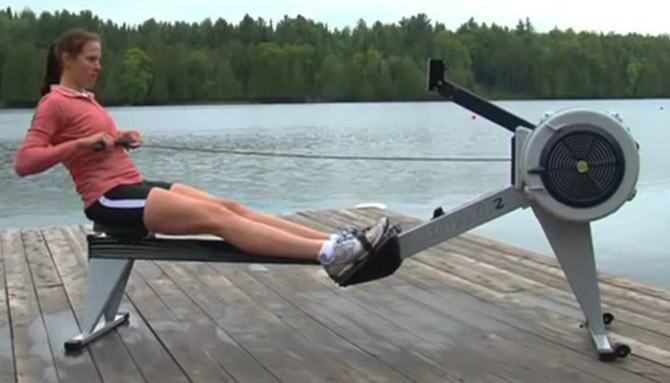Finish the Stroke and Release the Blade
The finish is the last part of the drive when the rower finishes accelerating the boat; the release happens after the finish when the rower taps the blade out of the water.
The finish and release are critical parts of the stroke because:
- rushing the finish to get ready for the next stroke will minimize a rower’s ability to send the boat away effectively and will upset the balance of the boat,
- a poor release can cause the blade to act as an anchor or as a rudder, slowing the boat down and upsetting boat balance, and
- a good finish and release leads to a good recovery and catch.
Body Position and Execution
You are in the finish position and ready to release the blade from the water when your legs are fully extended, you are sitting up tall in the 11 o’clock position and the handle is all the way into your body. Your wrists are flat with forearms parallel to the water.
Below is a picture of a rower finishing the stroke. Notice how the chest is open with relaxed shoulders. This will allow room to bring the handle in to the upper ribs and to move the handle down slightly to release the blade from the water.

Steps for a Perfect Finish and Release
| 1 | Just before the back finishes, draw your elbows straight back past your torso and squeeze your shoulder blades together. Your chest should be open and your shoulders should be back, down, and relaxed. Your outside arm should draw straight into your lower ribs to finish the work of the blade. |
| 2 | Tap down slightly with the outside hand, the one furthest away from the oarlock, to release the blade from the water. Note that this is a gentle tap down, not forceful. |
| 3 | To feather the blade, ensure that the blade is out of the water and turn your inside hand toward your body. The tap down with the outside hand and feathering with the inside hand must be separate movements. |
| 4 | Stay in the layback position as the hands move away on the first part of the recovery (this will happen in a continuous motion without hesitation). |
Key Points
- The early and middle parts of the drive create acceleration and momentum for a strong finish (acceleration creates space behind the blade allowing the blade to come out of the water).
- Maintain good posture and sit up tall as you draw the handle toward the body.
- Maintain power behind the handle, keeping pressure on the footplate, to continue accelerating the blade and to keep the pocket of water behind the blade. This will ensure a clean release.
- Be sure to draw the handle in high, versus pulling down into your lap, to ensure the blade stays buried and can send the boat away effectively.
- Do not stop the oar with your body. You must keep the oar handle moving continuously – touch and go.
Common Mistakes
- Lifting the shoulders during the drive – forces the blade to go deep and makes it difficult to release the blade from the water.
- Too much layback or lack of body control at the finish – makes it difficult to draw the oar in and extract the blade from the water. Also makes it difficult to feather the blade.
- Feathering the blade when it is still in the water. You may be throwing water as you extract the blade.
- Washing out at the finish by pulling the oar handle down into the lap rather than straight in to the body and finishing ahead of other crew members.
- Failing to apply force to the handle causes the puddle behind the blade to close up making it difficult to get the blade out of the water.
- Rowers finishing at different times and with different handle heights will upset boat balance.
Drills
Drills to develop a good finish:
- Blade placement drills in the finish position – tap the blade in and out of the water
- Square blade rowing
- On water or on the erg, practice the following:
- lifting slightly at the catch to establish the proper handle height for the drive and finish
- being attentive during the drive and finish to ensure that the hands follow a straight path from the handle position at the catch to a point on the body (usually the second rib), and
- tapping down after the finish and moving the hands straight away in a fluid motion